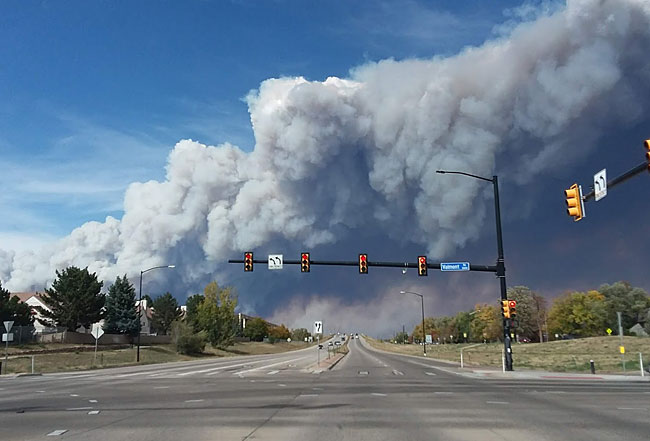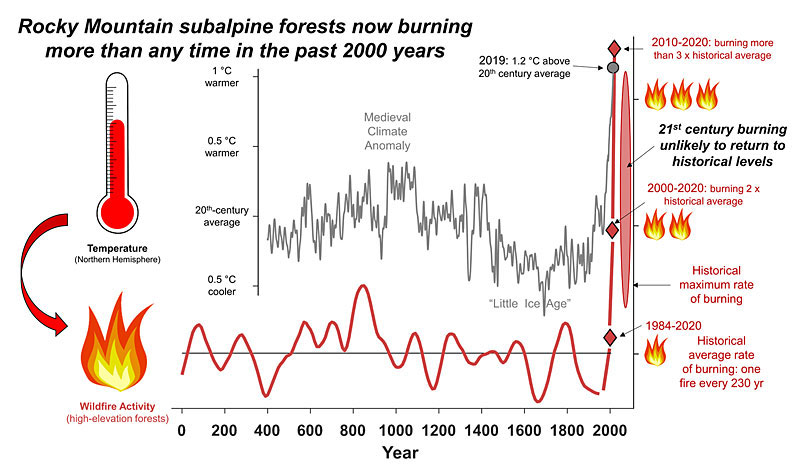UM Research: Rocky Mountain Forests Now Burning More Than Any Point in Past 2,000 Years

MISSOULA – Following 2020’s extreme fire season, high-elevation forests in the central Rocky Mountains now are burning more than at any point in the past 2,000 years, according to a new University of Montana study recently published in the Proceedings of the National Academy of Sciences.
Researchers from UM and the University of Wyoming analyzed a unique network of fire-history records to understand how 21st-century fire activity compares to wildfires in the past. The findings highlight that burning in recent decades in high-elevation forests of northern Colorado and southern Wyoming is unprecedented over the past several millennia.
As fire paleoecologists – scientists who study historical ecosystems – the team uses charcoal found in lake sediments to piece together the fire history of forests across the Rocky Mountains. The idea, said lead author and UM professor Philip Higuera, is that understanding the past is key to understanding changes we see today and how forests may change in the future.
When 2020’s massive fire season hit, its ferocity startled Higuera and his co-authors – UM doctoral candidate Kyra Wolf and UW Professor Bryan Shuman. Last year, wildfires in Colorado burned through October, unusually late in the year. By November, the 2020 wildfires alone were responsible for 72% of the total area burned in high-elevation forests since 1984 in their study region, and Colorado had seen three of its largest fires on record.

“As the 2020 fire season unfolded, we realized we already had a well-defined understanding of the fire history of many of the places burning, based on over 20 lake-sediment records our teams had collected over the past 15 years,” said Higuera, professor of fire ecology in the W.A. Franke College of Forestry and Conservation. “When the smoke settled, we thought ‘Wow, we may have witnessed something truly unprecedented here.’ So we combined the existing records for the first time and compared them to recent fire activity. To our surprise, 2020 indeed pushed fire activity outside the range of variability these forests have experienced over at least the past two millennia.”
The authors found that since 2000, wildfires are burning nearly twice as much area on average compared to the last 2,000 years. Whereas a high-elevation forest historically burned once every 230 years on average, in the 21st-century that has now shrunk to around 120 years. That’s more fire activity than occurred during the “Medieval Climate Anomaly,” a period around 1,200 years ago when temperatures spiked higher than they were during the 20th century.
While human activity and past fire suppression are important contributing factors to wildfires across the West, the work highlights increasingly warm, dry conditions as an overarching cause of increased burning in these high-elevation forests.
“It isn’t unexpected to have more fire as temperatures rise,” said co-author Wolf, who is studying fire history in the northern Rocky Mountains in UM’s Systems Ecology program. “Our records show that fire tracked past variations in climate just as it does today. What's striking is that temperatures, and correspondingly fire, are now exceeding the range that these forests have coped with for thousands of years – largely as a result of human-caused climate change.”
For decades, scientists have predicted that climate warming would increase wildfire activity in high-elevation forests beyond the range historically experienced, Higuera said.
“It’s sobering to see that it’s clearly happening, and early in the 21st century – not in 2050, not in 2075, but by 2020,” he said.
Overall, the study is another indication that extreme fire seasons like 2020 – or like 2017 in Montana – will become increasingly common as summers continue to become warmer and drier than in past centuries.
Higuera and colleagues have previously highlighted ways communities and managers can respond to increasing fire activity, but he hopes this paper helps illustrate the significant impacts of human-caused climate change on wildfire, forests and the human communities that live among them.
“It may sound dire,” Higuera said, “but it’s critical to remember that we have ample opportunities to limit or reverse climate warming while still working to adapt to the increasing fire activity expected in upcoming decades.”
The study, “Rocky Mountain subalpine forests now burning more than any time in recent millennia,” is online at https://www.pnas.org/content/118/25/e2103135118.

###
Contact: Philip Higuera, professor of fire ecology, philip.higuera@umontana.edu.
Note: Higuera published an article in The Conversation on June 14 titled "Climate change is making Rocky Mountain forests more flammable now than at any time in the past 2,000 years."